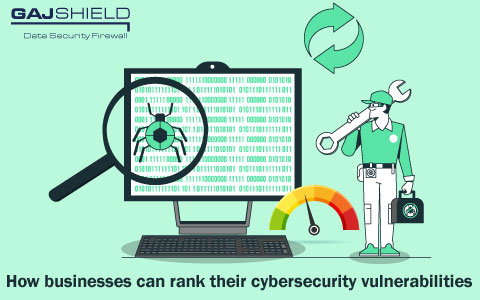How businesses can rank their cybersecurity vulnerabilities
Globally, organisations constantly make strategies to use their resources judiciously and achieve overall sustainability. This careful resource management extends to their cybersecurity efforts too. After all, there are hundreds, if not thousands, of cyber-threats organisations can face on a yearly basis. So, it does not make sense for them to use all their data security tools and personnel to deal with every single threat. But, how can you figure out the level of attention and resources needed to deal with any given data security threat? This is where data security vulnerability ranking comes in.

Why is vulnerability ranking important?
Not all data security threats are the same, with some being more vicious for your organisations than the others. At any given point, your organisation can find itself on the wrong end of threats such as malware, distributed denial or service (DDoS) attacks, spam and phishing attacks, ransomware, cross-site scripting, and many, many others. Ranking helps your business familiarise itself with the most common attacks among the ones specified here.
Once your organisation identifies its vulnerabilities: such as flaws or design issues in your computer network, poor internal security controls, issues with data security policy implementation, among others, they can be ranked according to the level of danger they cause and the resources needed to neutralise their impact
What are the main types of vulnerabilities?
Although there may be more sub-categories, here are some of the main vulnerability areas:
Software vulnerabilities
These can include oversights such as design flaws, a lack of audit trail, and insufficient testing, to other issues, such as memory safety issues, privilege-confusion bugs, or vulnerability to side channel attacks.
Hardware vulnerabilities
Hardware vulnerabilities can include physical factors, such as dust, natural disasters, water leakage-related issues, or soiling, or other ones, such as firmware vulnerabilities and poor encryption of networks.
Personnel vulnerabilities
Your employees can be an often-overlooked weakness in your holistic cybersecurity infrastructure. Issues such as insider attacks and social engineering are the result of personnel-related threat oversight. Personnel vulnerabilities include the lack of security awareness, poor security training, poor cyber-hygiene, incoherent recruitment policies, and others.
Management vulnerabilities
Management oversight in data security planning includes the lack of a future continuity plan, absent audit strategies, the lack of response procedures and many more.
Apart from these, other types include network vulnerabilities such as unprotected communication lines, insecure network architecture, authentication issues, and others.
How can you rank your cybersecurity vulnerabilities?
Ranking vulnerabilities is only possible after the types of vulnerability are known. Once those are known, businesses need to dive deep into their own networks, physical infrastructure and data security infrastructure to begin the ranking procedure, which goes like this:
Step 1: Identify vulnerability
Your business needs to carry out a full-fledged scan of all components: hardware, software, personnel, training programs, physical infrastructure, network, and others, to detect vulnerabilities. The vulnerabilities may be either from the above-mentioned list or belonging to other types. Essentially, if your security auditors — normally, they are the ones tasked with carrying out periodical data security vulnerability detection programs — find anything that may result in a cyber-attack in the future, that can be listed as a threat.
Step 2: Assess vulnerability severity
Once the vulnerabilities are identified, they can be evaluated. The severity of a vulnerability is directly linked to the likeliness of it being exploited in a cyber-attack is. Also, the type of data vulnerable is important too. For example, if a security loop-hole brings the possibility of an attacker gaining access to sensitive IP documents, then that is a bigger vulnerability than, say, a loop hole that may result in a weakened, standard DDoS attack.
There are several kinds of tools that can be used to measure vulnerability. For example, the Common Vulnerability Scoring System (CVSS) is a vulnerability measuring resource used by the National Vulnerability Database (NVD). This tool rates vulnerabilities on a 1-10 basis to simplify the process of ranking vulnerabilities for companies.
There are several tools available online that can provide vulnerability scoring for businesses across various sectors.
Step 3: Configure existing controls
After the previous step dabbled into the idea of prioritizing data according to its value, this step goes one step further and facilitates the creation of the necessary configuration changes needed to protect the company data against external threats while also ensuring that certain attacks will not hit the data network of a given organisation. Therefore, every vulnerability must be addressed before the company goes through with the remainder of the process.
Step 4: Repeat process for every vulnerability and rank them
Once all the possible vulnerabilities are known, an organisation must rank them based on the quantitative damage and losses they may cause. As per this ranking, the most ‘dangerous’ threats will be ranked in descending order. As stated earlier, having a list like this is useful for deploying just the right number of resources for the right kind of threat and making data security as efficient as possible for organisations.
For carrying out vulnerability evaluation checks and vulnerability ranking, you need data security experts with the right amount of technical nous and data security experience. Gajshield’s data security solutions and personnel possess the reliability and quality that you need to safeguard your data against all kinds of threats.
Kindly contact us to know more about our extensive list of data security solutions.
Get In Touch With Us
Subscribe to our Newsletter
2025 © GajShield Infotech (I) Pvt. Ltd. All rights reserved.
